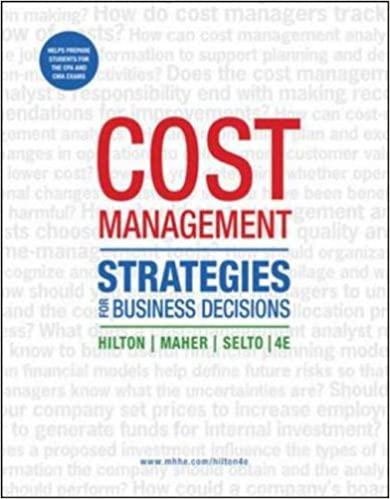Prague Glass & Crystal Company manufactures three types of glassware: unleaded glass, low-lead crystal, and high-lead crystal.
Question:
Prague Glass & Crystal Company manufactures three types of glassware: unleaded glass, low-lead crystal, and high-lead crystal. Glass quality increases with higher lead content, which allows for more detailed cutting and etching. Unleaded glass production is highly automated, but cutting and etching crystal products require a varying degree of labor, depending on the pattern’s intricacy. Prague Glass &
Crystal applies all indirect costs according to a predetermined rate based on direct-labor hours. A consultant recently suggested that the company switch to an activity-based costing system and prepared the following cost estimates for year 5 for the recommended cost drivers: Activity Cost-Driver Base Costs Driver Units Order processing Number of orders $ 30,000 150 orders Production setup Number of production runs 120,000 60 runs Material handling Number of pounds of materials used 100,000 80,000 pounds Machine depreciation Number of machine hours 80,000 8,000 hours and maintenance Quality control Number of inspections 20,000 4O inspections Packing Number of units 40,000 320,000 units Total estimated overhead $390,000 In addition, management estimated 5,000 direct-labor hours for year 5.
Assume that the following activities occurred in January of year 5:
Low-Lead High-Lead Unleaded Glass Crystal Crystal NUMOCKONUI ITS OKOGUCC CRN nines ettere e 20,000 8,000 3,000 DifectemealeiialiCOSiSs peace name teis wens ne $13,000 $8,000 $5,000 DirectlaberhOursas scewemaniae craewn a ar 150 150 200 Nuimbemotionderse7.c
a. nc besarancte eee e 4 3 2 NUmMOeCRORONOCUCHONINUMS tera ween Fenske eae | | 2 Number of pounds of material used............. 5,000 2,000 1,000 NUMmbeRolimechinewnOUrS sitamees tee e 580 140 80 NumlbenOhinspecliomSmme itas amkecn actin cium 1 1 1 Numberofunits shipped ...........0.. 00.08. 20,000 8,000 3,000 Actual direct-labor costs were $15 per hour.
Required
a. (1) Compute a predetermined overhead rate for year 5 for each cost driver using the estimated costs and estimated cost-driver units prepared by the consultant. (2) Also compute a predetermined overhead rate for year 5 using direct-labor hours as the allocation base.
b. Compute the production costs for each product for January using direct-labor hours as the allocation base and the predetermined overhead rate computed in requirement (a,2).
c. Compute the production costs for each product for January using the cost drivers recommended by the consultant and the predetermined rates computed in requirement (a,1). (Note: Do not assume that total overhead applied to products in January will be the same for activity-based costing as it was for the labor-hour-based allocation.)
d. Management has seen your numbers and wants to know how you account for the discrepancy between the product costs using direct-labor hours as the allocation base and the product costs using activity-based costing. Write a brief response to management.
Step by Step Answer:

Cost Management Strategies For Business Decisions
ISBN: 12
4th Edition
Authors: Ronald Hilton, Michael Maher, Frank Selto





